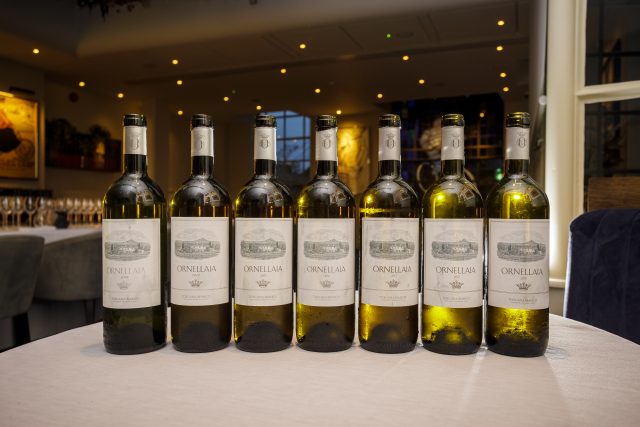This website uses cookies so that we can provide you with the best user experience possible. Cookie information is stored in your browser and performs functions such as recognising you when you return to our website and helping our team to understand which sections of the website you find most interesting and useful.
Ornellaia Bianco 2013-2019: Bolgheri’s ‘alter ego’
At a vertical tasting of seven vintages of Ornellaia Bianco, estate director Axel Heinz explained that he’s “still learning a lot” from Bolgheri.

“There are a lot of paradoxes about Bolgheri: it is in Tuscany, but isn’t known for Tuscan varieties, it is near the sea, but is better known for red wines, and it is a relatively new appellation, but has already acquired a big reputation.”
While Ornellaia did produce a white wine before 2013, Heinz said that it was more akin to a New Zealand or Loire style, rather than what he strove for, which was: “[a white wine] that would speak more of its place and more of Ornellaia.”
“It may seem a little bit early for us to do a vertical tasting for a wine that has only existed for 10 years,” Heinz explained, “but, even if it’s only a first phase we thought it would be good to explore.”
This “first phase”, with vintages from 2013 to 2019 available, has seen production oscillate between 4,000 and 10,000 bottles and Heinz experiment with the varieties and techniques used, though Sauvignon Blanc remains front and centre. For Heinz, one of Sauvignon Blanc’s great advantages is that it can ripen “to a level of richness without losing acidity”. He also likes that it “doesn’t reach extravagant levels of alcohol”.
However, 2013, the inaugural vintage, contained 30% Viognier, a variety that was left out entirely from some subsequent vintages because of its temperamental nature: “Viognier can add weight and richness – but there’s a very fine line between being oppullent and being heavy, and it’s just a matter of a few days.” Despite being nine-years-old, the 2013 has retained much of its freshness, even though that year had a hot, dry summer.
For 2014, the blend was changed, with 74% Sauvignon Blanc, 13% Viognier and 13% Petit Manseng. Heinz summarised this as “a cool, rainy vintage, not particularly favourable to the reds. But it was more interesting for the whites as we could let them ripen for longer”. As a result, picking began in September, rather than late August. “’14 is the vintage I would love to see in a few years,” confesses Heniz, “it’s certainly a vintage that came a bit early, when we were still trying things out.”
One thing that was tried out was opting to produce single-varietal whites. Both the 2015 and 2016 were made from 100% Sauvignon Blanc, both were fermented in oak barriques (30% new, 70% old) at 22°C, and both were lees-aged for 12 months. However, the 2015, “a much warmer year” than 2016, has what Heinz called “an element of surprise”: “’15 is evolving slower and more in the way we would expect…’16 is more advanced than what we would have expected.”
2017 was “as challenging as one might think for the whites”, with conditions so hot and dry that Sauvignon Blanc picking began on 7 August. “I was still on holiday,” joked Heinz. “[2017] is never going to be the greatest vintage,” said Heinz, “but it’s ageing much better than what we imagined.”
By contrast, as 2018 was a cold year, the harvest was much later: “[It was the] vintage where we felt we had the possibility to find out how late we could harvest…We felt comfortable in letting the grapes hang.” That year, Sauvignon Blanc picking concluded in mid-September, while Viognier was harvested at the end of August. It was also the first year where the wine was lees-aged for 10 months, rather than 12.
2019, on the other hand, is when Heinz believes that Ornellaia Bianco truly found its “aromatic finesse”: “[2019 was] a bounce back from 2018, when we maybe went a bit far in terms of hang time…I very much like the ’19, because it is fruitier and crisper.” The 2019 is also 19% Viognier, the highest percentage of the variety since 2013.
As for this year’s harvest, Heinz noted that intense summer heat caused “crueller conditions” than were experienced from 2018 to 2021, but that the eventual rain resulted in a vintage of “two halves…before and after the rain”.
It isn’t just the weather that has pushed the 2022 vintage into “unfamiliar territory”, this year is also marks the first time that Sémillon was harvested. “We shall see what that does,” remarked Heinz.
To read more about Ornellaia’s 2019s, white and red, click here.

